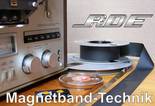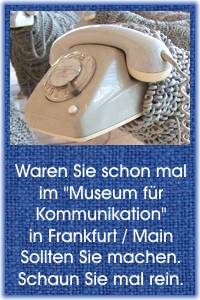Zum Auffrischen und Schmunzeln . . .
. . . sind diese Museums-Seiten hier gedacht, denn viele wissen nicht mehr oder noch nicht, wie es damals angefangen hat und wie das wirklich funktioniert mit den Tonband- und den Magnetbandgeräten aus alter Zeit. Viele Bilder können Sie durch Anklicken vergrößern, auch dieses.
Die Story über Ampex (3) von 12
Die magnetische Aufzeichnung des Hifi-Ton´s gelingt endlich (so sehen es jedenfalls die Amerikaner)
When a symphony is recorded on magnetic tape, the sound waves of the instruments are converted into electrical signals by the microphone. Capturing and reproducing those signals with unerring fidelity was the prime objective of the young Ampex Electric and Manufacturing Company in 1948 through 1950.
Not immediately obvious to anyone at that time was, that any physical phenomena, which could be converted into electrical signals, could be recorded on magnetic tape. This discovery was to open up new markets which held greater potential than the application for audio recording.
A Project from Washington
By 1950, Ampex was firmly established as a producer of professional magnetic recorders for radio networks and the recording industry. By this time, Alexander M. Poniatoff had added two more engineers to his staff, to work on further development of units which were in production and to plan for the next generation of recorders.
At this time, Joseph A. McMicking, the man who brought financial support and his personal enthusiasm about the future of tape recording to Ampex in its early days, returned from one of his trips to Washington with a challenging question. He asked Poniatoff, if the frequency response of the Model 300 could be extended from 22 to 100 kilocycles to allow the equipment to be used for a new application recording phenomena other than sound.
The question provided the opportunity to test the talent and ability of the newly expanded engineering group at Ampex. Poniatoff's concern for excellence which displayed itself in the precision design of the Model 300 was the factor, that allowed the unit, to be adapted to this new requirement without great difficulty. The specifications were met. Instrumentation tape recording became a reality.
McMicking, who served on MacArthur's staff during World War II, and at one time was Eisenhower's flight instructor, maintained his contact with top military personnel in Washington. He discussed Ampex magnetic recorders with members of the military technical group and learned from them their special requirements.
Later, after another of his trips to Washington, McMicking asked, if Ampex could develop a unit, which would record all low frequencies down to zero. This would create a new fieid of application for magnetic recording, he stated.
The first reaction for an engineer, familiar with the principles of magnetic recording, was, that this could not be done. The difficult task was accomplished, however, with the development and introduction of the FM (frequency modulation) principle. Ampex was now in the instrumentation recording business, but the practical aspects such as the small number of readily availabie customers for these products did not indicate the potential of the field. The big problem yet remained to be solved. Who were the prospective customers for these new recording units and how could Ampex reach them?
New Markets for Instrumentation
At the time Ampex was conducting its first instrumentation development work for the government, Tom Davis, Engineering Sales Manager for Bing Crosby Enterprises, was independently seeking new applications for Ampex products. Bing Crosby Enterprises had distribution rights for all Ampex products and Davis was responsible for marketing these products in the 11 Western states.
Thomas E. Davis had earned a B.S.E.E, at the University of California at Los Angeles, and did post-graduate work at Columbia University. At the end of World War II, he became affiliated with Bing Crosby Enterprises and was immediately introduced to the new Ampex recorders.
"From the first time I laid eyes on the Ampex recorder, I was fascinated by its possible applications," Davis states. "I could see the potential of the new recording technology. After studying the Ampex recorders, and consulting closely with the Ampex engineers, I was highly interested in the idea of instrumentation applications. I realized that any signal recorded on magnetic tape could be reproduced later as many times as required. Engineers and scientific personnel could repeat the original experiment playing a magnetic recording over and over, instead of relying on the traditional Single observation.
"So with a heavy Model 300 in the back of my Station wagon, I took to the road and besides look-ing for sound recording customers I sought new applications for this amazing unit."
"I never really sold an instrumentation recorder. My efforts were to find a person with a potential company, an engineer who could understand the possible uses of magnetic recording. I did everything possible to interest him in trying the recorder in his work. My philosophy is that if the equipment is entirely new, you would have to let your customer himself experiment with the unit. I found this policy will bring orders in a fairly short time."
At Point Mugu, the Raytheon Company, under contract to Hughes Aircraft, was involved in the testing of missiles called "Loons." The Loon studies required the analysis of Signals from the missile to determine the effects environmental influences had on flight behavior. After Davis' presentation about the capabilities of the new instrumentation recorder and seeing the product in use, Raytheon ordered 25 Model 301s (modified Model 300s) at the approximate price of $4,600 a unit.
Davis went back to Crosby Enterprises an excited young man. He saw enormous potential for magnetic recording in instrumentation and he wasted no time exploiting it. Following this, Davis sold two 300s to a professor at Cal Tech, who was studying earthquakes, and he sold one to the California Research Corp. (a Standard Oil subsidiary near Los Angeles) for oil seismic research. Then he received a contract for two 301s from the University of Washington´s neurological department in Seattle for the study of brain waves of monkeys. He even took a 300, one bizarre afternoon, piece by piece, up to the belfry of the Pasadena Presbyterian Church and demonstrated, how a recorder could preserve the tolling of bells, sermons and other ecclesiastical acoustics.
By this time, Ampex began to be known as a producer of instrumentation recorders. Next, it was learned that the U. S. Navy required a recorder which would withstand severe environmental conditions. This initiated the development of the first militarized unit, the Model 500. Davis, as a representative of Crosby Enterprises, had so much confidence in this recorder, that he placed an order with Ampex for 50 recorders at $17,250 a unit. Today, Davis admits, that he had sold all of these recorders even before Ampex had produced them.
In 1955, Ampex developed the first recorder, which industry and science could use for a variety of applications. It did not have to be adapted or modified for different customers. Tom Davis' selling talents and ability to discover new applications for magnetic recording assisted Ampex in establishing itself in the forefront of the instrumentation business at this early stage in the development of the magnetic recording industry.
In 1956, when the Company terminated its agreement with Bing Crosby Enterprises, Davis joined Ampex. At this time Ampex opened a sales office in Los Angeles appointing Davis as manager. In three months he became Western Regional Manager. In three more months he became National Sales Manager for instrumentation products as Ampex divisionalized its audio and instrumentation product activities. Davis is presently a Group Vice President with responsibility for guiding the Professional Audio, Professional Video, and Special Products Divisions, Marketing Services and the Colorado Springs Operations.
In the years since Tom Davis pounded the pavement uncovering new applications for instrumentation recorders, the market for these products has grown broad and highly sophisticated. Today, Ampex instrumentation recorders can be found in aircraft, submarines, satellites, missile and satellite tracking stations, manufacturing plants, hospitals, oceanological laboratories and Communications Systems.
The Vietnam war curbed non-military government programs with the result, that the instrumentation recording industry leveled off. Though Ampex has not been as seriousiy affected by the reduction in government spending as its competitors, it has felt the impact of the diversion of government funds away from research to armament.
In spite of the damper the Vietnam war places on the industry, Ampex continues to seek markets and engage in development of new technology for the day when the end of the war will bring about new demands for instrumentation equipment.
THEATER SOUND
In 1952, Alexander M. Poniatoff received a call from a New York banker, who said, that a very important person was going to visit Ampex. The banker could not disclose the identity of the mysterious visitor or the purpose of his visit, but indicated, it could mean important new business for Ampex. He suggested to Mr. Poniatoff that he extend all appropriate courtesies.
On the appointed day, a chauffeur-driven limousine pulled up at 934 Charter Street, Redwood City, and a man emerged who introduced himself to Ampex personnel as "Mr. Edwards." Poniatoff and the others were puzzled by the fact that his large, gold cuff links and tie pin bore the initials "MT."
"Mr. Edwards" asked the Ampex group who met him if they had seen Cinerama (the original production was released shortly before "Mr. Edwards'" visit). When the Ampex executives indicated they had, he asked what they thought of the new film technique. After a general discussion of the many merits of this pioneer movie achievement, the visitor asked if Ampex could record sound on photographic film with a magnetic coating. As it happened, Ampex was working on a guided missile instrumentation project at the time which used 35 mm film coated with magnetic material. Film with sprocket holes was used to accomplish long-term stability in the motion of the coated film. As a result, the answer to "Mr. Edwards' " question was "yes."
He next asked if Ampex had done any work in stereophonie recording of sound. At this time, Ampex maintained a stereophonie demonstration room in the same building. After listening to the System, the visitor became highly impressed with what he had heard. Upon returning to the office to continue the conference, the visitor revealed that he was, in reality, not "Mr. Edwards," but Mike Todd.
Mr. Todd then announced that as a result of what he had been shown, he was selecting Ampex to produce the sound system for the fortheoming Todd-AO motion picture System (a technique even more advanced than the new Cinerama process). In 1955, the first Todd-AO film "Oklahoma" was released featuring the new six-track sound System developed by Ampex. This was the first Ampex entry into the theater sound business.
In December, 1960, the Ampex theater sound System was presented to the Academy of Motion Picture Arts and Sciences. On the basis of its performance, and the accolades of sound engineers at several major studios, the Academy voted to award Ampex an Oscar for technical achievement.
When "The Robe" was released, amid Publicity which heralded Cinemascope as the screen technique of the future, it featured, unknown to the average moviegoer, a new Ampex stereo system. Ampex surrounded movie audiences with sound in 1967 when it introduced a system known as Dimension 150. The solid-state, eight-track System features five speakers behind the movie screen and a group of speakers throughout the theater for off-screen sound effects.
Ampex Sound Systems are presently in use in theaters throughout the world.



